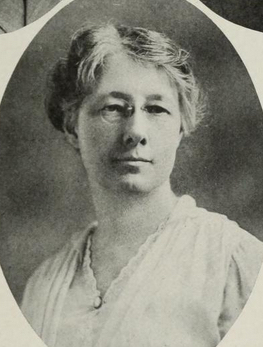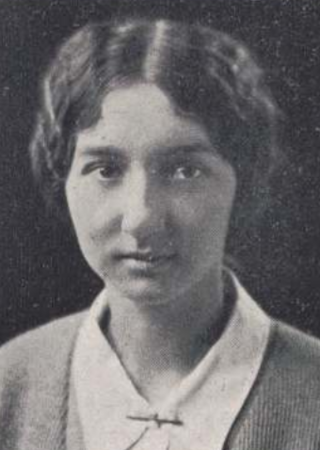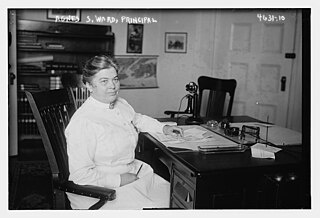Related Research Articles

Isabel Adams Hampton Robb (1859–1910) was an American nurse theorist, author, nursing school administrator and early leader. Hampton was the first Superintendent of Nurses at the Johns Hopkins School of Nursing, wrote several influential textbooks, and helped to found the organizations that became known as the National League for Nursing, the International Council of Nurses, and the American Nurses Association. Hampton also played a large role in advancing the social status of nursing through her work in developing a curriculum of more advanced training during her time at the Johns Hopkins School of Nursing.
Susan Edith Tracy was an American registered nurse who developed invalid occupations as a branch of nursing.:118 Tracy was a founder member of the National Society for the Promotion of Occupational Therapy. She was an educator and author, instigating the first training course about occupation and writing the first textbook about the therapeutic benefits of occupation.

Alma E. Foerster (1885–1967) was an American nurse who worked in both civilian and military care. She began her career as a public health nurse in Chicago and during the First World War helped establish hospitals in Kiev, for which she received the Cross of Saint Anna. She worked in Romania, receiving the Order of the Cross of Queen Marie for her service, before being sent on a humanitarian mission to Archangel, Russia. As one of only two American Red Cross nurses in Archangel, she provided assistance at the military surgical hospital, while the other nurse assisted with civilian nursing. She was one of the inaugural recipients of the Florence Nightingale Medal in 1920. After her return to the United States, she worked in the United States Public Health Service as a nurse, instructor and director of nursing in Chicago, Mobile, Ann Arbor and Racine, before returning to Chicago where she ended her career.
Louie Croft Boyd was an American nurse, hospital superintendent of nurses, nursing instructor, and writer. As a lobbyist for the newly formed Colorado State Trained Nurses Association, she advocated for legislation to regulate the licensing of nurses in Colorado. Upon passage of the bill in 1905, she applied for and became the first licensed nurse in the state. She was posthumously inducted into the Colorado Nurses Association Hall of Fame and the Colorado Women's Hall of Fame in 2004.
Nora Neve (1873-1952) was a British nurse and medical missionary with the Church Missionary Society who pioneered missionary nursing. Her work was instrumental in the development of the Kashmir Mission Hospital in Srinagar. She was the hospital's first Superintendent of Nursing and led education and cleanliness initiatives. Neve also recorded and published records of Kashmiri hospital practices in the American Journal of Nursing, contributing to the tool kits of other missionaries and preserving a part of Kashmir's cultural history.

Georgia Marquis Nevins was an American nurse, nursing educator, and hospital administrator.

Nell Viola Beeby was an Indian-born American nurse. She was a nursing educator in China and went on to become editor-in-chief of The American Journal of Nursing.

Mary Elizabeth MacCallum Scott was a Canadian physician and Christian medical missionary who spent twenty years in Ceylon. She was the first female doctor to serve in Jaffna, Ceylon. Scott started the first nursing school in Ceylon at Manipay and her training of women nurses was considered by historians to be “revolutionary” at the time.

Petra Fitzalieu Pinn was an American nurse and hospital administrator, and president of the National Association of Colored Graduate Nurses (NACGN) in 1923 and 1924.

Anne Lyon Hanson was an English nurse who emigrated to the US. She was a leader in the areas of public health and social work.
The Lincoln School for Nurses, also known as Lincoln Hospital and Nursing Home School for Nurses, and Lincoln Hospital School of Nursing, was the first nursing school for African-American women in New York City. It existed from 1898 to 1961. It was founded by Lincoln Hospital in Manhattan. The hospital and nursing school, moved to 141st Street, between Concord Avenue and Southern Boulevard in Mott Haven, the South Bronx, after 1899.

Mary Louise Petty was an American army nurse during World War II. Petty was the first Black member of the U.S. Army Nurse Corps to achieve the rank of captain. She supervised a nurse training program at Fort Huachuca, and led the first group of Black nurses sent to serve in Europe in 1945.

Helen Maria Roser was an American nurse and nursing educator. She was associate director of the Hartford Hospital School of Nursing, and co-author of an anatomy and physiology textbook for nurses.

Mary May Roberts (1877–1959) was an American nurse and long-time editor of the American Journal of Nursing. She was a chief nurse and director at the Army School of Nursing, Camp Sherman, during World War I and was inducted into the American Nurses Association Hall of Fame in 1984.

Katharine DeWitt (1867–1963) was an American nurse, writer and co-editor of the American Journal of Nursing.

Nellie Xenia Hawkinson was an American nurse and nursing educator. She led nursing education programs at Western Reserve University and the University of Chicago. She was twice president of the National League for Nursing Education.

Ella Phillips Crandall (1871–1938) was an American nurse and a pioneer in public health nursing. She was the executive secretary of the National Organization for Public Health Nursing from 1912 to 1920. She served on the board of directors of the American Nurses Association and was on the faculty of Teachers College, Columbia University.

Marian E. RottmanFleming was an American nurse. She was director of nursing at Bellevue and Allied Hospitals in New York, and served overseas in World War I.

Agnes S. Ward was a Scottish-born American nurse, medical missionary in Africa, and nursing educator. She was principal of the Metropolitan Hospital Training School for Nurses in New York City, and superintendent of nurses for the New York City Department of Welfare.

Claribel Augusta Wheeler was an American nurse, educator, and hospital administrator. She was executive secretary of the National League of Nursing Education from 1932 to 1942, superintendent of the Washington University School of Nursing from 1923 to 1931, and president of the Ohio State Nurses Association.
References
- 1 2 3 4 "Obituary for MARY CURTIS WHEELER". Pensacola News Journal; Pensacola, Florida. 1944-10-03. Retrieved 2024-11-05.
- 1 2 Dittmer, Arlis (2016-03-13). "Blessing Hospital superintendent pushed for nurse education, licensing". www.hsqac.org. Retrieved 2024-11-05.
- 1 2 3 4 "Who's Who in the Nursing World: Mary Curtis Wheeler". The American Journal of Nursing. 23 (1): 33–34. 1922. ISSN 0002-936X. JSTOR 3407268.
- 1 2 3 4 5 6 "Obituaries". The American Journal of Nursing. 45 (2): 164–164. 1945. ISSN 0002-936X.
- ↑ "Plan to link nurses' school with U. of C." Chicago Tribune; Chicago, Illinois. 1924-09-14. Retrieved 2024-11-05.
- ↑ Reviews of Nursing Technic
- W., M. M. M. (1931). "Review of Nursing Technic". The American Journal of Nursing. 31 (4): 522–523. doi:10.2307/3410476. ISSN 0002-936X.
- Norcross, Mary E. (1923). "Review of Nursing Technic". The American Journal of Nursing. 23 (9): 819–820. doi:10.2307/3407566. ISSN 0002-936X.